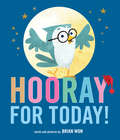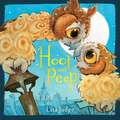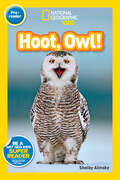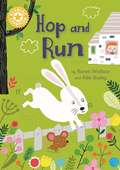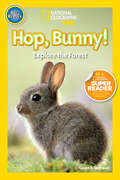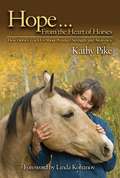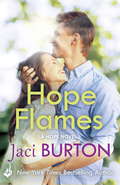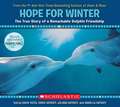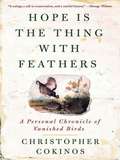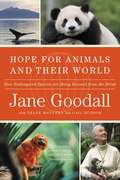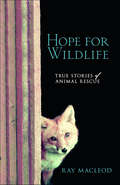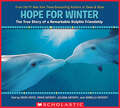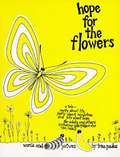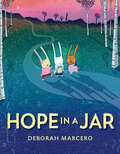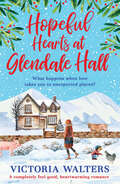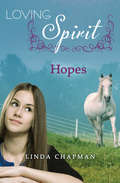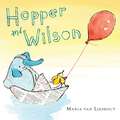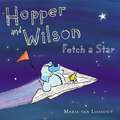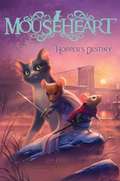- Table View
- List View
Hooray for Snail!
by John StadlerSlow Snail hits the ball so hard during a baseball game that it flies to the moon and back. Will Snail have time to slide in for a home run?
Hooray for Today!
by Brian WonWhen the moon is up, Owl is wide awake and ready for fun: “Hooray for today! Would you like to play?” But everyone says, “Not now! I’m sleepy!” Owl’s playday gets lonely fast as each friend turns her away—until sunrise, when Owl discovers a friendly surprise. Perfect for little ones learning the art of patience, Hooray for Today! celebrates playtime, sharing, and friendship.
Hoot and Peep (Hoot and Peep)
by Lita JudgeIn the night skies above Paris, an adorable young owl teaches her older brother about the power of imagination—and the unconditional love between siblings Hoot the owl is very excited for his little sister, Peep, to join him on the cathedral rooftops. She's finally old enough to learn all his big brother owly wisdom: First, owls say hooo. Second, they always say hooo. Lastly, they ONLY say hooo! But why would Peep say hooo when she could say schweeepty peep or dingity dong? Why would she speak when she could sing? As she explores the breathtaking Parisian cityscape, Peep discovers so many inspiring sights and sounds—the ring of cathedral bells, the slap of waves on stone—that she can&’t help but be swept up in the magic of it all. Hoot doesn&’t understand Peep&’s awe, until he takes a pause to listen . . . and realizes that you're never too old to learn a little something new.From the beloved author/illustrator of the classic picture book Red Sled, this gorgeous read aloud celebrates the wonder found in little things—and in the hearts of dreamers, young and old.
Hoot, Owl! (National Geographic Kids Readers)
by Shelby AlinskyThis pre-reader uses simple vocabulary and fun pictures to capture the interest and help develop the skills of beginning readers. The humorous and fun information about one of nature's most intriguing animals makes this new reading experience a treat.
Hooting, Tooting Dinosaurs (Dinosaur Train)
by Andrea Posner-Sanchez Paul ConradKids ages 3-6 love watching Jim Henson's Dinosaur Train on PBS KIDS--and they love reading about their favorite dinosaurs Buddy, Shiny, Tiny, and Don. This Little Golden Book retells the episode in which the Pteranodon family goes to a concert performed by Corythosaurus. These cool dinosaurs have a crest on their head that helps them communicate--and make music!
Hop Up! Wriggle Over!
by Elizabeth Honey“Hop up! Wriggle over! Wakey-wakey: hungry!” Thus starts a full and busy day for an appealing animal family. Simple onomatopoeic words and irresistible illustrations capture familiar routines in a young read-aloud containing a warm and subtle reminder that families come in all shapes and sizes.
Hop and Run: Independent Reading Yellow 3 (Reading Champion #133)
by Karen WallaceReading Champion offers independent reading books for children to practise and reinforce their developing reading skills.Fantastic, original stories are accompanied by engaging artwork and a reading activity. Each book has been carefully graded so that it can be matched to a child's reading ability, encouraging reading for pleasure.Independent Reading Yellow stories are perfect for children aged 4+ who are reading at book band 3 (Yellow) in classroom reading lessons.In this story, Rabbit and Mouse start showing off - but Rabbit cannot hop quite as high as he would like!
Hop, Bunny!: Explore the Forest (National Geographic Kids Readers)
by Susan B. NeumanThe National Geographic Readers series has expanded beyond elementary school levels to reach children at the very beginning of their lifelong relationship with reading. Hop, Bunny! uses simple vocabulary and fun pictures to capture the interest and help develop the skills of beginning readers. The cuteness, humor, and fun information make this new reading experience a treat.
Hope (Angels on Assignment)
by Megan L. EnglishHope has some exciting adventures to share with you. Hope always believes that the situation will get better. Hope keeps going, even when the going is hard, or there is no reason to expect anything good. Hope knows that God has lots of wonderful things in store for His children!
Hope . . . From the Heart of Horses: How Horses Teach Us About Presence, Strength, and Awareness
by Linda Kohanov Kathy PikeHope . . . From the Heart of Horses explores and celebrates the relationship and bond possible between horses and humans. Each chapter offers a life lesson about trusting one's instincts, honestly addressing emotions, achieving clarity in communications, and re-leasing negative thoughts. Because survival depends on being highly tuned to the thoughts and feelings of others, horses sense human intentions rather than what a person offers in facial expressions, which creates a remarkable effect on the relationship between these two distinctly different species. Among the moving stories the author relates are a horse named Hope who teaches the difference be-tween hope and faith; an abused horse's background bringing up old memories and helping the author to move on; a young Olympic equestrienne hopeful who dis-covers and reaffirms her self-esteem; and a corporate training session in which one participant achieves great success merely by being honest about her fears. As you see how these people grow deeper into them-selves as they learn the horse's way, you, too, will be inspired to explore and apply the deep and ever-lasting connection and communication between horses and humans.
Hope Flames: Hope Book 1 (Hope #1)
by Jaci BurtonHope Flames is the first in the sexy, heartwarming Hope series from Jaci Burton, New York Times bestselling author of the Play-By-Play series. Perfect for fans of Bella Andre, Jill Shalvis and Nora Roberts.Welcome to Hope, Oklahoma. The small town that's sure to warm your heart. Full of big hearts, fiery passion and love everlasting...When it comes to love, they already know the rules...by heart. Thirty-two and finally setting up her veterinary practice in the town she once called home, Emma Burnett is on her own and loving it. Independent and driven, she's not letting any man get in the way of her dreams - not again. That's fine with Luke McCormack. Divorced and hardly lacking in female company when he needs it, he's devoted to the only faithful companion in his life - his police dog. Still, there's something about Emma he can't shake. When a series of local break-ins leaves Emma vulnerable, she seeks help from the first man to spark her desire in years. And now they're giving each other something they thought they'd lost forever...hope.For more romance to warm your heart, check out the rest of the Hope series, or look for Jaci's sexy sports romance series, Play-By-Play, beginning with The Perfect Play.
Hope For Winter: The True Story of a Remarkable Dolphin Friendship
by Isabella Hatkoff Juliana Hatkoff Craig Hatkoff David YatesThe true story of a baby dolphin named Hope who was rescued against all odds. Exactly 5 years and 1 day after Winter, the tailless dolphin who inspired a major motion picture featuring Morgan Freeman, Ashley Judd, and Harry Conick Jr. , was rescued, something pretty amazing happened. Just feet from where Winter was found, appeared another injured dolphin, orphaned from her mother and struggling to survive. The Clearwater Marine team quickly went to work, attempting to nurse this new dolphin back to health. After a tough fight fought by the little dolphin and by the Clearwater team, the dolphin grew strong and healthy. She now lives with Winter and crowds flock to the aquarium to see them play. Her tale is one of courage and triumph. She was named Hope and this book tells her story.
Hope Is the Thing With Feathers
by Christopher CokinosWeaves together natural history, biology, sociology, and personal narrative to tell the story of the lives, habitats, and deaths of six extinct bird species. This book is, in part, an effort to make certain that we never again forget extinct species nor the others of which Cokinos write. As Cokinos traveled to libraries and natural history museums, he learned of other vanished birds: the Ivory-billed Woodpecker, the Heath Hen, the Passenger Pigeon, the Labrador Duck and the Great Auk. He was moved to write about them, and the result is this impressive book about the ¿ghost species¿ of the North American continent. The cover has the look of stained and mottled pages from a naturalist¿s notebook. Illustrations.
Hope Is the Thing With Feathers
by Christopher CokinosA prizewinning poet and nature writer weaves together natural history, biology, sociology, and personal narrative to tell the story of the lives, habitats, and deaths of six extinct bird species.
Hope for Animals and Their World: How Endangered Species Are Being Rescued from the Brink
by Jane Goodall Gail Hudson Thane MaynardAt a time when animal species are becoming extinct on every continent and we are confronted with bad news about the environment nearly every day, Jane Goodall, one of the world's most renowned scientists, brings us inspiring news about the future of the animal kingdom. With the insatiable curiosity and conversational prose that have made her a bestselling author, Goodall-along with Cincinnati Zoo Director Thane Maynard-shares fascinating survival stories about the American Crocodile, the California Condor, the Black-Footed Ferret, and more; all formerly endangered species and species once on the verge of extinction whose populations are now being regenerated.Interweaving her own first-hand experiences in the field with the compelling research of premier scientists, Goodall illuminates the heroic efforts of dedicated environmentalists and the truly critical need to protect the habitats of these beloved species. At once a celebration of the animal kingdom and a passionate call to arms, HOPE FOR ANIMALS THEIR WORLD presents an uplifting, hopeful message for the future of animal-human coexistence.
Hope for Wildlife: True Stories of Animal Resuce
by Ray MacLeodOne day, a couple who had run over a skunk with their car brought it to the Dartmouth Veterinary Hospital. When the veterinarians couldn't look after it, Hope Swinimer decided to take the helpless animal into her care, and that was the start of it all. Now, through her rehabilitation centre called Hope for Wildlife, Hope's name is synonymous with wildlife rescue in Nova Scotia.Since 1997, hundreds of animals have been saved through the tireless efforts of the staff and volunteers at Hope for Wildlife. Some animals' stories were so unique that they even garnered national attention-such as Hope's battle with the department of natural resources over Gretel, a member of the endangered pine marten species. Each creature comes with its own challenges, either through a particularly difficult injury or a quirky personality-like Lucifer the inexplicably bald and ornery raccoon-but each patient leaves an indelible mark on the lives of those around them.Hope for Wildlife tells the stories of fourteen different wild animals from Nova Scotia that have passed through the centre. Colour photographs of the animals and the centre's efforts supplement the text, and info boxes offer further information on the province's wildlife. The stories in Hope for Wildlife are educational, heartwarming, and sometimes heartbreaking-but always filled with hope.
Hope for Winter: The True Story of a Remarkable Dolphin Friendship
by Craig Hatkoff David YatesA story of a baby dolphin named Hope is rescued against all odds.Exactly 5 years and 1 day after Winter, the tailless dolphin who inspired a major motion picture featuring Morgan Freeman, Ashley Judd, and Harry Conick Jr., was rescued, something pretty amazing happened. Just feet from where Winter was found, appeared another injured dolphin, orphaned from her mother and struggling to survive. The Clearwater Marine team quickly went to work, attempting to nurse this new dolphin back to health. After a tough fight fought by the little dolphin and by the Clearwater team, the dolphin grew strong and healthy. She now lives with Winter and crowds flock to the aquarium to see them play. Her tale is one of courage and triumph. She was named Hope and this book tells her story.
Hope for the Flowers
by Trina PaulusA modern-day fable that has given hope and inspiration to millions.
Hope in a Jar
by Deborah MarceroIn this companion to the acclaimed and bestselling picture books In a Jar and Out of a Jar, a little bunny and his friends collect their hopes and dreams for the future in jars.Llewellyn the bunny and his friends dream of many things. Some of their dreams are small, like learning to ice skate, visiting a friend, or acting in the school play. And some of their dreams are big, like going to the moon, or becoming a ballet dancer or a wildlife photographer. Their dreams feel so precious that the bunnies place them in jars for safekeeping. But when a storm comes and destroys their collection of jars, Llewellyn and his friends wonder: what's the point of dreaming if everything could be lost?This timely, powerful, and beautifully illustrated story of perseverance and resilience explores setbacks, loss, and grief, and shows how—with the help of friends and loved ones—to find the strength to start again.
Hopeful Hearts at Glendale Hall: The cosiest, most uplifting read to warm your heart this winter! (Glendale Hall)
by Victoria Walters‘Emotional, moving, funny, heartwarming - this novel has got it all. Highly recommended!’ Samantha Tonge, author of The Winter We MetWhat happens when love takes you to unexpected places?Heather Douglas appears to have it all. But living on a farm in the Scottish Highlands with her partner, Rory Fraser, all while bringing up their adorable toddler, Harry, isn’t easy. As a former librarian, Heather is worried that she’ll never fully fit into life on Fraser Farm. And after the death of her beloved mum eight years ago, Heather feels lost, as well as guilty for holding back accepting Rory’s marriage proposal because she can’t imagine her wedding without her mother.So when ex-boyfriend, Stewart, appears in the village of Glendale, it’s a shock to the system. The man who broke her heart years ago now has big plans for the neighbouring farm and wants Heather to be part of the development. Knowing that she’s living a very different life to the one they had planned at university leaves Heather wondering if she has made the right choices since she and Stewart broke up. Especially when things start to go very wrong on the farm ...This Christmas, Heather will need to face her fears and let go of the past or risk losing everything. She will need love, faith, and a whole lot of hope!Return to the beautiful Highlands village of Glendale with the latest book in the bestselling Glendale series – the perfect cosy, uplifting, romantic read for fans of Heidi Swain, Milly Johnson and Holly Martin.Praise for Hopeful Hearts at Glendale Hall:'A delightful and heartwarming read. I really enjoyed escaping to Glendale, and getting to know the warm and varied characters.' Caroline Roberts, author of The Cosy Teashop in the Castle series and Rachel's Pudding Pantry‘a gorgeous feel-good story…I'm already looking forward to the next one!’ Jessica Redland, author of Finding Love at Hedgehog Hollow'A festive farmland treat with deep snow and even deeper heart!' Isla Gordon, author of A Season in the Snow‘a magical setting, characters that feel like family, and plenty of drama…the best one yet in this enchanting series’ Books of All Kinds‘I absolutely loved this book… beautifully written and a really easy, feel good read and a perfect escape.’ A Girl Who Loves to Read‘A brilliantly written, deliciously witty and highly moving tale… sheer perfection from beginning to end!’ ????? Bookish Jottings‘a truly magical and enchanting read. I absolutely loved it’ ????? Little Miss Book Lover‘read at any time when you need something comforting and cosy and want to escape from the world for a while.’ Book Lover Worm‘If you’re looking for a feelgood story to make you smile, then look no further!’ Roberta ReadsI’ve fallen in love with this uplifting story and with the entire town of Glendale...I wish the characters were real!’ ????? ReadwithAbi‘I’d love to move to Glendale… I truly hope there will be more books in the series because this is a triumph!!! An easy ????? from me!’ Head in a Book‘This was a fun, heartfelt read which I really enjoyed and would highly recommend it.’ Cheryl’s Bookworm Reads‘totally captured my heart and left me with a feeling of loss as I reached the end.’ Love the Smell of a Book
Hopes (Loving Spirit #3)
by Linda ChapmanWhen fate threatens to take Spirit away from her, Ellie fights to save her horseWhen she moved to England after her parents&’ death, Ellie felt alone until the day she met Spirit, the skinny gray horse who seemed to see directly into her soul. At first, she simply loved him, but soon she learned of their secret connection—and her incredible ability to speak to horses without opening her mouth. This gift has helped her feel at home on her cruel uncle&’s horse ranch, but when Spirit is threatened, her power may not be enough to save him. Ellie gets worried when Spirit stops eating. He tells her that he&’s happy, but how can she be sure? With her relationship with her horse and her cousin Joe both in danger, Ellie learns a hard lesson about love. But nothing can break the special bond that she and Spirit share.
Hopper and Wilson
by Maria van LieshoutA playful tale about friendship and home"What," Hopper asks his little friend Wilson, "do you think it's like at the end of the world?" Hopper, the blue elephant, imagines a staircase to the moon, while Wilson, the yellow mouse, hopes for an endless supply of lemonade. So the two sail off in a boat made of paper . . . only to discover they already have everything they could wish for in each other, and at home. Maria van Lieshout's adorable new picture book tugs at heartstrings, inspires discussion, and reminds us all how good returning home can feel.Praise for HOPPER AND WILSON"...van Lieshout's story is filled with adventure, emotion, and imagery that supplies lots of effervescent warmth."--Publisher's Weekly"Winsomely ambiguous and otherworldly, this sweet, quirky story offers fantastic footholds for dizzying discussion."--Kirkus Reviews
Hopper and Wilson Fetch a Star
by Maria van LieshoutHave you ever wanted your very own star?Wouldn't it be wonderful to have your own star for a nightlight? It is this thought that begins Hopper and Wilson's second adventure. They fill their airplane with lemonade and soar into the night sky. So many stars to choose from! One is too pointy. One is too heavy. Another is too bright! Taking a break on the moon, the two friends look directly above and spot it—the perfect star! As Hopper lays down for a nap, Wilson ventures off on his own, to the dark side of the moon. Yet now he is lost! How can he find his way back to Hopper?The perfect star, of course. Wilson spots it in the sky and follows it back to his friend. In another deceptively simple story, Maria van Lieshout shows how sometimes the best part of nature is that it's found only in nature—and that everything has its proper place . . . be it stars or even best friends, who always belong together.
Hopper's Destiny
by Vivienne To Lisa FiedlerA brave mouse attempts to rebuild a fallen empire in this second book of the epic Mouseheart series set in the subway tunnels of Brooklyn, and for "fans of Erin Hunter, Brian Jaques, and Kathryn Lasky" (School Library Journal).The battle to free Titus's camps is over, and Hopper, Zucker, Firren, and their loyal followers are working to rebuild. But the tunnels are in a state of chaos, and without the sinister peace accord to protect the rodents, Queen Felina and her growing army of ferals is a greater threat than ever before. In the Mūs Village, Pinkie has led a coup and is now ruling with an iron paw. And Pup has become cold and defiant, a change that Hopper never saw coming. When exterminators raid the tunnels, Hopper is snatched away by the intruders and taken back up to the daylight world where he was born. Upland, Hopper makes new allies, and as he enjoys the sights and sounds of Brooklyn, he wonders if he will ever make it back into the tunnels to restore safety and prosperity, as foretold by La Rocha's prophecy. But why should Hopper fulfill a destiny he never wanted in the first place? Learn more at Mouseheart.com!
Hopper's Destiny
by Vivienne To Lisa FiedlerA brave mouse attempts to rebuild a fallen empire in this second book of the epic Mouseheart series set in the subway tunnels of Brooklyn, and for "fans of Erin Hunter, Brian Jacques, and Kathryn Lasky" (School Library Journal).The battle to free Titus's camps is over, and Hopper, Zucker, Firren, and their loyal followers are working to rebuild. But the tunnels are in a state of chaos, and without the sinister peace accord to protect the rodents, Queen Felina and her growing army of ferals is a greater threat than ever before. In the Mūs Village, Pinkie has led a coup and is now ruling with an iron paw. And Pup has become cold and defiant, a change that Hopper never saw coming. When exterminators raid the tunnels, Hopper is snatched away by the intruders and taken back up to the daylight world where he was born. Upland, Hopper makes new allies, and as he enjoys the sights and sounds of Brooklyn, he wonders if he will ever make it back into the tunnels to restore safety and prosperity, as foretold by La Rocha's prophecy. But why should Hopper fulfill a destiny he never wanted in the first place? Learn more at Mouseheart.com!

